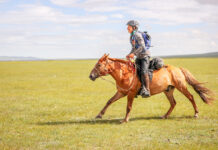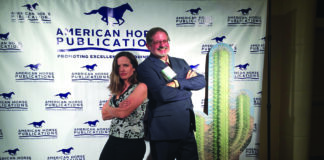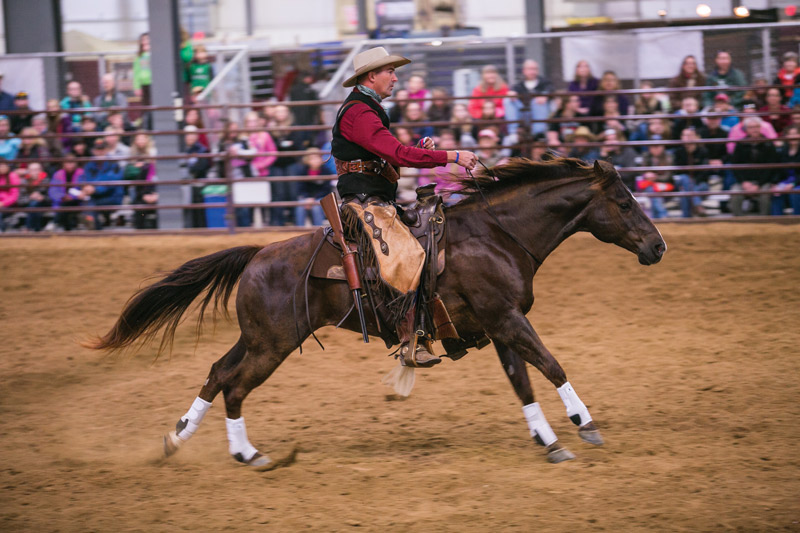
If you’ve been to a horse expo, you’ve probably seen a bridleless riding demonstration. The lack of tack looks like an inspiring next plane of communication and connection with your horse. But is bridleless riding an attainable goal for all?
Peters says riding bridleless at high speed isn’t a good goal for everyone. However, training your horse so you don’t need to rely on the reins will help your communication at any level.
“Not every horse should be ridden bridleless,” Peters says. “At home, I almost never practice without a bridle on my horse’s head. I put my reins down and ride in bridleless style. When I ride without my reins, I’m just testing all the ingredients I have built into the foundation and connection.”
Read on to gain tips to help you ride with more seat and fewer rein cues, no matter your end goal.
Far Off Dream
Peters first became aware of bridleless riding when he attended Ohio’s Equine Affaire and saw Pat and Linda Parelli’s demonstration, and later Stacy Westfall’s iconic ride at American Quarter Horse Congress.
“[Westfall] blew the world’s socks off with her first bridleless freestyle reining ride,” he says. “I thought, not only can bridleless be done, but it can be done well at speed. There was so much grace, poise and refinement in her ride.”
Peters worked as part of the Parelli team for three years to learn more about connected riding. Peters’ longtime mentor, Bobby Ruwe, pushed Peters to combine what he learned from the Parellis with mounted shooting.
“I told him I had this dream to run a whole mounted shooting pattern bridleless,” Peters says. “He thought I was crazy.”
Ruwe approached him at a later competition and asked about his goal.
“Want to try it today?”
With 800 people watching, Peters rode bridleless in a shooting competition and was only two seconds slower than his usual time.
For the next two years, he practiced and rode bridleless in competition if he had already made a mistake with the bridle on. Finally, his run times matched his bridled rides.
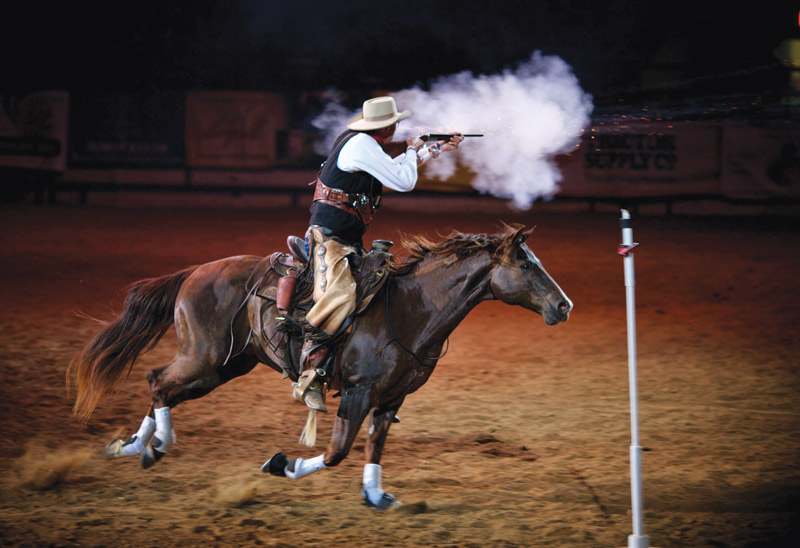
Training Process
Peters says you must go through a process to learn control. You must be an accomplished rider first—with the ability to stop and turn your horse with subtle cues.
First, you’ll work on your cues to make sure that you can control your horse without constantly pulling on the reins. Peters explains you should work with a bridle on while you put your reining hand down on the horse’s mane. Your goal will be to not pick up your hand. Your leg and seat aids will accomplish your cues.
Next, you’ll keep the bridle on and ride with the reins in one hand while your opposite hand carries a “carrot stick” (long training stick) resting against your shoulder.
“Riding with the carrot stick helps to push your horse’s turns a little more and reinforce the cues,” Peters says. “For instance, with a turn, you should look, turn your belly button and use your legs. If the horse still doesn’t answer your body cues, the stick comes in to help reinforce those cues and get the turn.”
Instead of reaching for the reins, rhythmically move your stick toward your horse’s nose. For a light correction, simply wave the air. Take the pressure away and return the stick to your shoulder if the horse follows your cue.
“If the horse doesn’t respond, gently touch the horse’s nose or shoulder,” Peters says. “Touch just enough that the horse’s hair can feel it. A firmer touch means that the horse’s skin can feel it. A tag is when you touch with enough pressure so that their muscles feel pressure.”
Peters cautions against using the stick for too much pressure.
“I pick my reins up and support with the bridle and keep that touch going until the horse responds from the bridle, then I take away the bridle cue and the stick.”
Final Test
Before taking off the bridle, tie your split reins together so that you can ride without handling them—but know you could pick them up if needed. Peters says he adds two training sticks.
“Do all your riding with the sticks and your focus, belly button and seat,” he says. “When I can get everything done with a bridle but riding as if I don’t have a bridle, and I get my horse up to speed, stop and back up on every single ride, every single day, only then I can move on.”
Peters’ next step is to remove the bridle and practice with a neck rope and sticks. With time taken at all the previous stages, he says his sticks rarely move from their position on his shoulders.
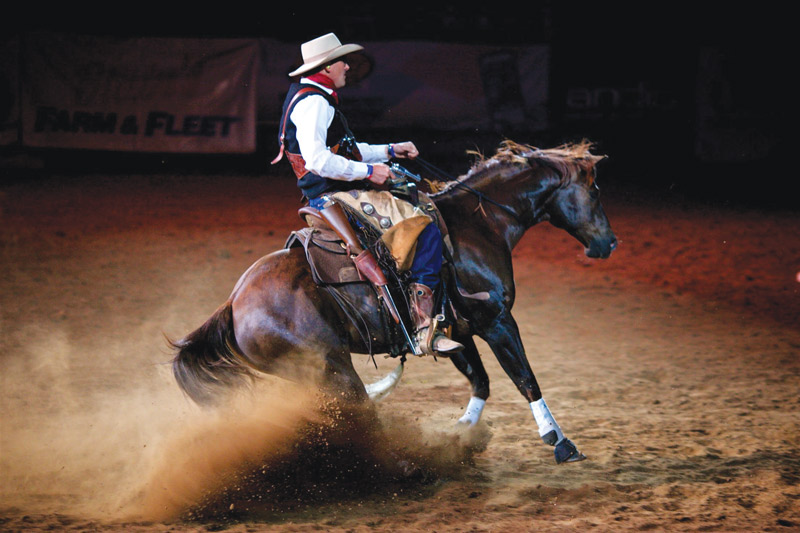
“I can drop the sticks and ride only with the neck rope support, with all cues coming from my focus, my legs and my seat.”
The time it takes to move through these stages is different for every horse and rider. If your horse is naturally obedient, it may take less time. Some more highly dominant horses may never be good candidates for going fully bridleless.
“Some students define bridleless as being able to ride at a walk and trot with the reins over the horse’s neck while holding one stick. That might be their end goal. That’s up to them to decide.” Does bridleless riding have a purpose deeper than showing off your skills?
“[For me] it was to have a better connection with my horse,” says Peters. “Obviously it wasn’t about winning, because at first I was going slower when I took the bridle off. It was about doing something that hadn’t been done consistently by someone else at the time. It was about doing something special.”
Bridleless MishapsBridleless mounted shooting competitor and 5 Star Master Parelli Instructor Jesse Peters warns riders not to try bridleless without preparation. “After I saw Pat and Linda at Equine Affaire, I was inspired,” he says. “I got on my mare bridleless and bareback. She took off at full speed for seven or eight laps. I couldn’t get her to stop. I was just blessed to be a good rider and I stayed on. I jumped off and thought bridleless riding isn’t possible yet. It’s something you shouldn’t do at home. That was my reality check that you should not be doing this until you’re ready. “I have seen people [doing] mounted shooting take the bridle off to see if they’re ready rather than building bridleless into a training regimen. It’s not safe to just take the bridle off and try.” |
The Money RideLongtime horsemanship trainer and 5 Star Master Parelli Instructor Jesse Peters’ years of practice and his commitment to following his dreams led him to the big event at the Midwest Horse Fair. Here’s his memory of his $10,000-earning win (shown below). “There were 8,000 people screaming, the house was dark, we start to run into the arena. My horse said, ‘I don’t think I can do it.’ I could feel his energy like a bomb about to go off. I told him I was asking him to go, and he complied. “I rode into the arena with a bridle and then stopped, took it off and spun it out into the arena. We had three minutes to perform. I started out with the maneuvers I had been doing bridleless at home. I did a reining pattern and showed I was riding without hands. I got my horse used to riding in the arena with spotlights. I needed to give him the time to move around the arena and feel safe. “From there, I put in a few stops and spins and shot into the air. Then I started while shooting. I rode a reining-style, figure-eight pattern so that I could use the whole arena. I wanted to bring the energy through the whole house. “The fireworks went off and sprayed 20 feet in the air. Then I put the pistols away and took my shotgun out to take out the last two targets. At the end, I got off my horse, and with a tremendous amount of adrenaline, I tipped my hat to my horse and hugged him. We walked out together. We competed against some amazing riders and walked out as champions with $10,000.” Jesse Peters is a 5-Star Master Parelli Instructor based in Greenville, Ohio. Peters’ horse, Great Pine Whiz is a 2006 Quarter Horse gelding. Visit www.JesseRPeters.com for his clinic schedule. |
This article about riding bridleless appeared in the November/December 2020 issue of Horse Illustrated magazine. Click here to subscribe!



